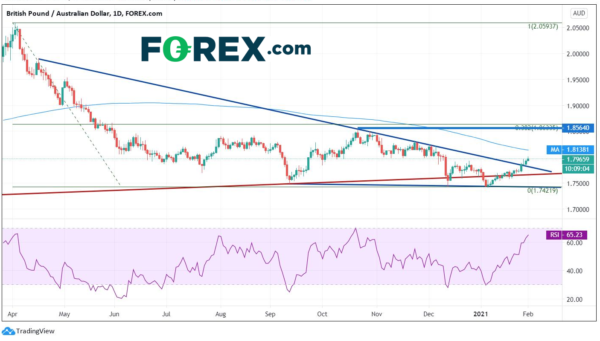One month after the Brexit trade deadline, Britain is already looking to join a new trading bloc, the Comprehensive and Progressive Agreement for Trans-Pacific Partnership (CPTPP), which includes countries such as Japan, Australia and Canada. This would allow the UK to set up bilateral agreements with China and the US. However, slowdowns have are already hurting factories in the UK as supply chains have been disrupted at the European borders due to the fallout from Brexit. This is in addition to the affects the coronavirus has had on the UK, which continues to be in lockdown. New variants and mutations are complicating the efforts to slow the spread of the virus, and the vaccine rollout has been slow. Last week, Boris Johnson said he hopes schools can reopen on March 8th! The BOE meets on Thursday for their first interest rate decision meeting of 2021. Rates are expected to be on hold, as Governor Andrew Baily said just last week that no decisions have been made on negative rates. However, there is the possibility that the central bank may increase the size of its bond purchase program.
Over the weekend, China released NBS Manufacturing PMI and non-manufacturing PMI. Both moved lower, with the non-manufacturing data moving to its lower level since February last year. Input prices continued to increase, and sentiment decreased to an 11-month low. Australia is a large exporter to China. A slowdown in China will hurt the Australian economy. The worse data comes as a fresh round of coronavirus cases have come through China ahead of the Lunar New Year. Australia is having a possible return of coronavirus as well, as Perth enters into a 5-day lockdown. The country has been Covid-free for 2 weeks prior the current lockdown. The situation needs to be monitored to see if cases increase. This will be on the mind of the RBA, who meet on Tuesday. Expectations are for unchanged rates at 0.25%, though employment has recovered nicely from the pandemic lows. The RBA has said they will not move rates until inflation is sustainably withing their 2%-3% target.
GBP/AUD has been moving lower since putting in its pandemic highs on March 11th, 2020. In doing so, the pair has formed a descending wedge and last week, GBP/AUD broke above the downward sloping top trendline of the wedge near its apex at 1.7860. In addition, GBP/AUD twice failed to break below the weekly upward sloping trendline (red), dating back to March 2017. The target for a descending wedge is a 100% retracement of the wedge, which is near 2.0600, however there is a good deal of resistance to get through before that point!
Source: Tradingview, FOREX.com
On a 240-minute timeframe, the GBP/AUD is trading at the 50% retracement level of the October 22nd, 2020 highs to the double bottom lows on December 11th and January 6th, near 1.7960, a key level if the pair is to break higher. In addition, the pair is breaking out of a double bottom pattern. The target of a double bottom is the height of the bottom to the neckline, added to the breakout point, which is near 1.8325. First resistance is the 61.8% Fibonacci retracement level of the previously mentioned timeframe near 1.8110. The 200 Day Moving Average sits just above there at 1.8138 (see daily) and final horizontal resistance before the target is 1.8337. If price fails at current key levels, short-term horizontal support sits below at 1.7681 and 1.7548 before the double bottom lows at 1.7422.
Source: Tradingview, FOREX.com
As noted in the Week Ahead, both the BOE and the RBA meet this week. Also, RBA Governor Lowe speaks a few times, which may also be telling for direction of GBP/AUD. In addition, variants of the coronavirus in the UK, as well as current lockdowns in both countries, (or at least in parts in Australia) many add to uncertainty to GBP/AUD this week.


 Signal2forex.com - Best Forex robots and signals
Signal2forex.com - Best Forex robots and signals




